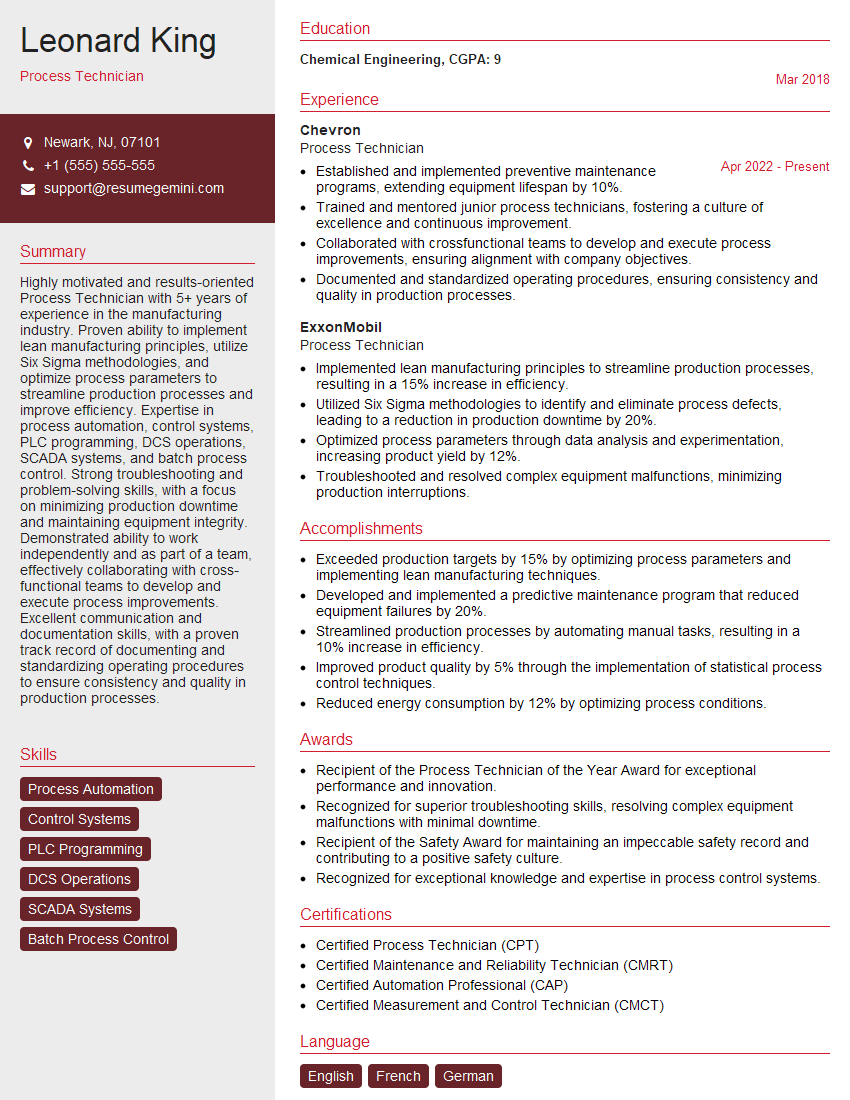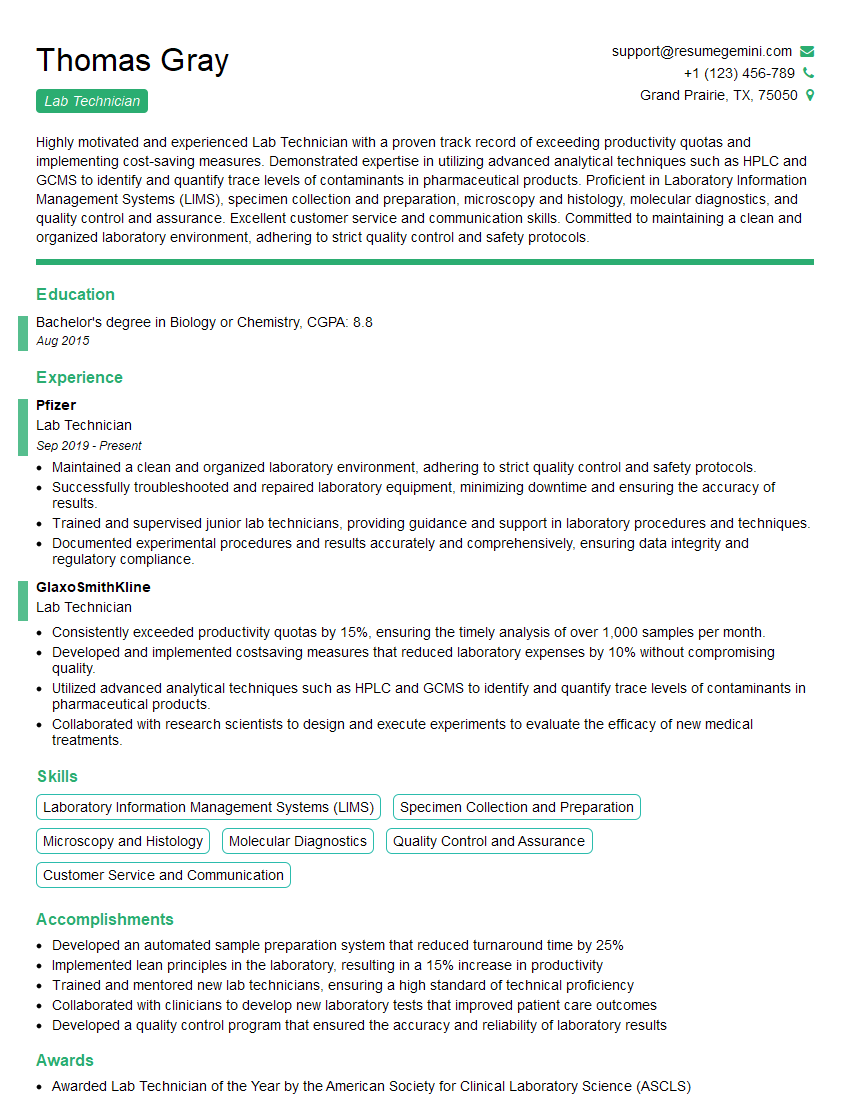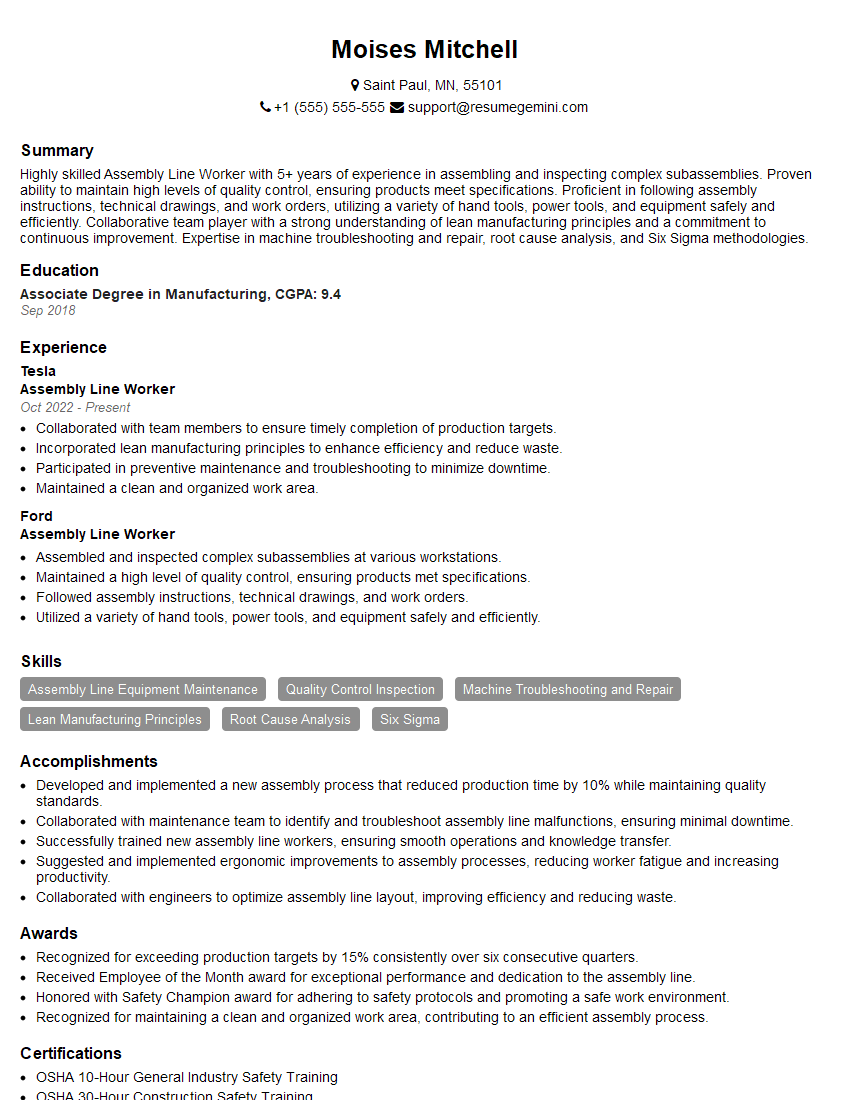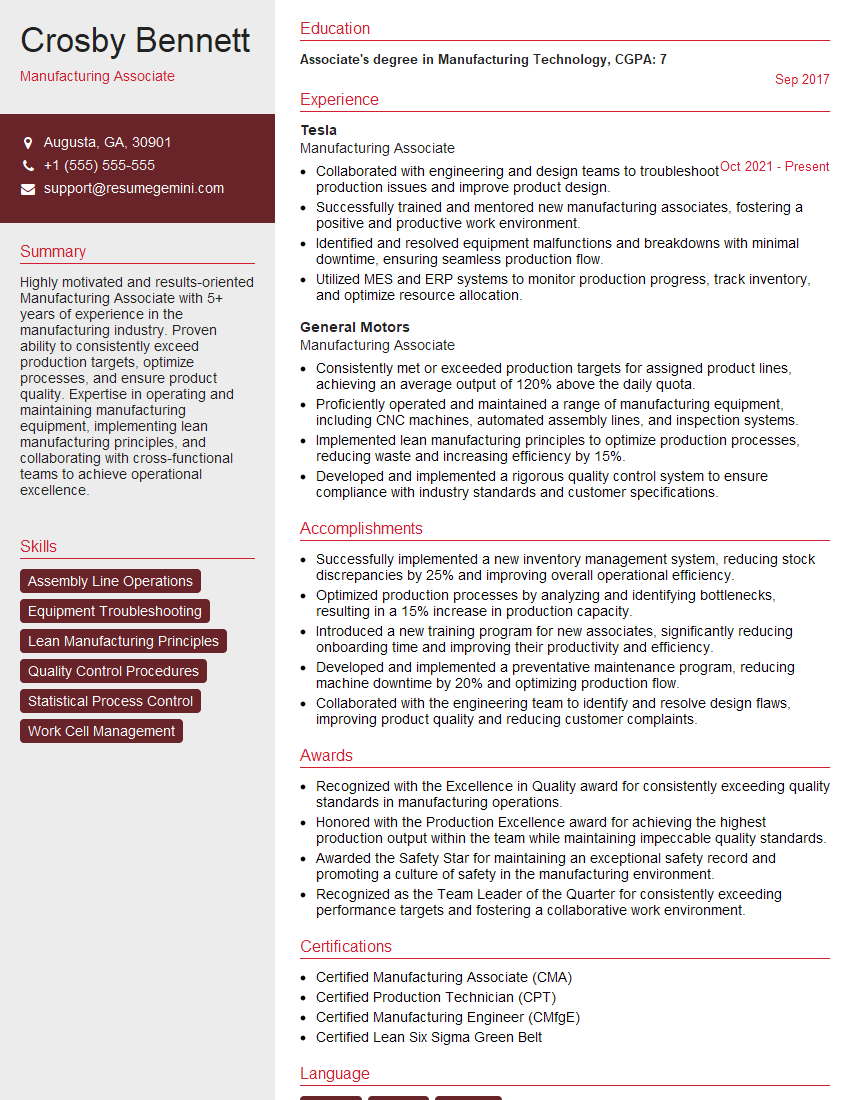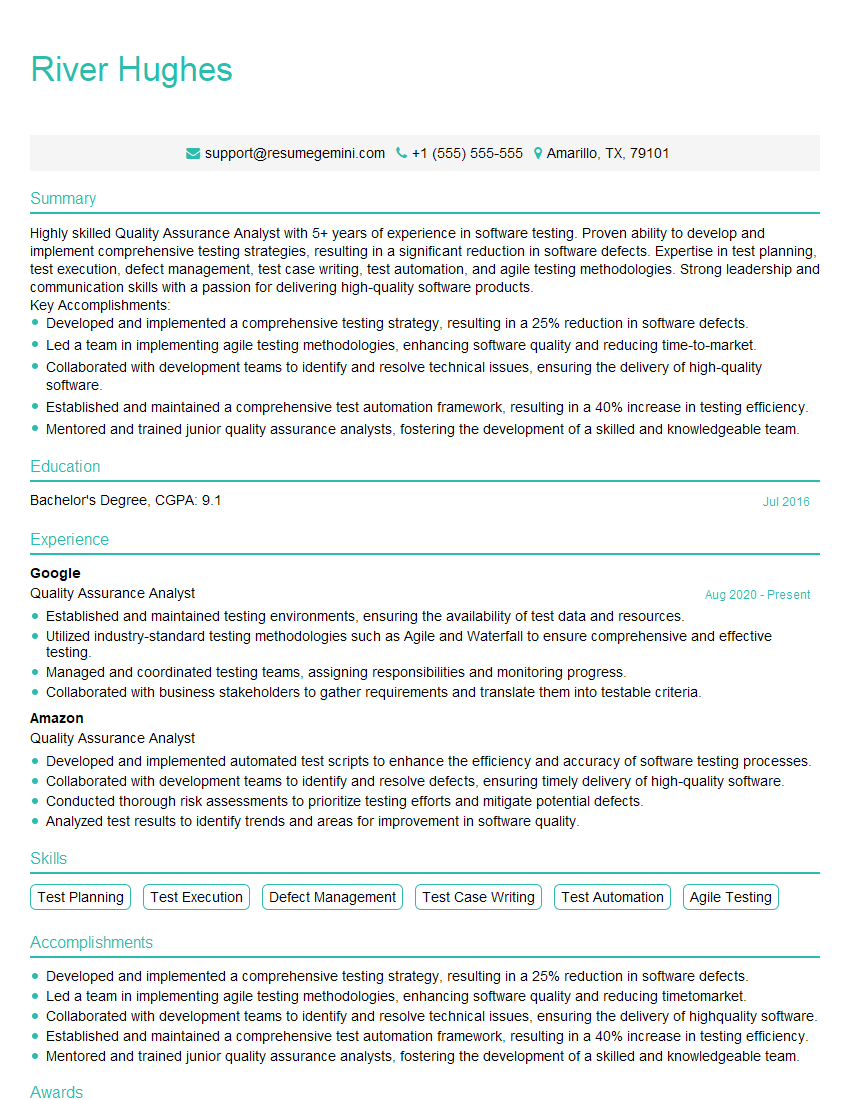The thought of an interview can be nerve-wracking, but the right preparation can make all the difference. Explore this comprehensive guide to Read, understand, and implement work instructions interview questions and gain the confidence you need to showcase your abilities and secure the role.
Questions Asked in Read, understand, and implement work instructions Interview
Q 1. Describe your process for reviewing work instructions before starting a task.
Before starting any task, I meticulously review the work instructions using a structured approach. My process involves three key steps:
- Initial Scan: I first skim the entire document to get a general understanding of the task, its scope, and the overall procedure. This helps me grasp the big picture before diving into the details.
- Detailed Review: Next, I carefully read each step, paying close attention to specific instructions, safety precautions, required tools, and expected outcomes. I highlight key points or anything that requires further clarification.
- Mental Rehearsal: Finally, I mentally walk through the entire process, visualizing each step and anticipating potential challenges or variations. This helps identify any potential issues beforehand and prepares me for smooth execution.
For example, if the instructions involve assembling a complex piece of machinery, I would carefully note the sequence of assembly, the torque specifications for each bolt, and the safety measures to prevent injury. This preemptive review significantly reduces errors and enhances efficiency.
Q 2. How do you handle ambiguous or unclear instructions?
Ambiguity in instructions is a common challenge. My approach involves a multi-pronged strategy:
- Seek Clarification: If any instruction is unclear, my first step is to seek clarification from the appropriate supervisor or subject matter expert. This is crucial to avoid errors and ensure compliance with safety regulations.
- Analyze Context: I carefully analyze the surrounding instructions and related documentation to infer the intended meaning. Sometimes, contextual clues can resolve minor ambiguities.
- Document Concerns: If clarification is not immediately available, I thoroughly document the ambiguous section and my interpretation in a log or report. This ensures a clear audit trail and helps prevent similar issues in the future.
- Proceed Cautiously: If there is significant ambiguity that can’t be immediately resolved, I’ll proceed cautiously, focusing on the parts of the instruction I understand completely, and halting work until clarification is received.
For instance, if the instructions mention a ‘standard’ size component without specifying dimensions, I would consult existing specifications or ask for confirmation to avoid using an incorrect part.
Q 3. What steps do you take to ensure you understand all aspects of a work instruction?
Ensuring complete understanding of work instructions is paramount. I employ these steps:
- Multiple Readings: I read the instructions multiple times, each time focusing on different aspects. This ensures I don’t miss any crucial details.
- Visual Aids: I utilize diagrams, illustrations, or videos (if available) to complement the written instructions and gain a clearer understanding.
- Cross-referencing: I verify information with other relevant documentation, such as technical drawings or specifications.
- Questioning: If aspects remain unclear, I proactively seek clarification from knowledgeable individuals.
Consider building a custom cabinet. If the instructions mention ‘attach panel A to frame B using screws,’ I would check the diagram to confirm the exact locations for screw placement and the type and size of screws needed. This thorough approach prevents mistakes and ensures a high-quality end product.
Q 4. How do you verify the accuracy of your work against the given instructions?
Verification is a crucial step to ensure accuracy. I follow these steps:
- Step-by-step Comparison: After each step, I compare my work against the written instructions, checking for alignment in materials, procedures, and expected results.
- Measurements and Checks: I use measuring tools and other verification methods to confirm the accuracy of my work against the specified tolerances and requirements.
- Visual Inspection: I conduct a thorough visual inspection to identify any defects or deviations from the instructions.
- Documentation: I maintain a log or record to document the completion of each step and any discrepancies found.
For example, if I’m wiring a circuit board, I will use a multimeter to verify the connections and the continuity of the circuit, ensuring they match the schematic diagram provided in the instructions.
Q 5. Have you ever identified an error or inefficiency in a set of work instructions? How did you handle it?
Yes, I have identified errors and inefficiencies in work instructions. In one instance, I discovered a missing step in the assembly process of a particular component. This oversight could lead to malfunction. I documented the missing step, including photos and a detailed explanation of the potential issue, and submitted this to my supervisor. The work instructions were subsequently updated, preventing potential problems for other team members.
In another case, I noticed the instructions were repetitive and inefficient. I suggested a streamlined approach, leading to a significant reduction in assembly time without compromising quality. This suggestion was well-received and implemented, improving overall productivity.
Q 6. Explain a time you had to adapt work instructions to a unique situation.
In one project, I was tasked with installing a piece of equipment in a location with unexpected spatial constraints. The existing work instructions didn’t account for these limitations. I carefully reviewed the instructions and identified steps that could be modified to accommodate the space limitations without compromising safety or functionality. I documented these changes, obtained approval from my supervisor, and successfully completed the installation. This involved using different mounting hardware and a slightly altered assembly sequence, all while adhering to safety protocols.
Q 7. How do you prioritize tasks when multiple work instructions are involved?
When multiple work instructions are involved, prioritization is key. My approach is based on several factors:
- Urgency and Deadlines: Tasks with imminent deadlines or those crucial for subsequent steps are given higher priority.
- Dependencies: Tasks that are prerequisites for others are prioritized to avoid delays in the overall process.
- Impact: Tasks with significant impact on the project’s outcome or those posing potential risks are prioritized.
- Resource Allocation: I consider available resources (time, materials, tools) to ensure optimal allocation across tasks.
I often use a task management system or a simple prioritized list to organize and track my progress, ensuring efficient task completion.
Q 8. How do you manage your time effectively when following detailed work instructions?
Effective time management when following work instructions is crucial for efficiency and accuracy. My approach involves a multi-step process: First, I thoroughly review the entire instruction set before starting, identifying the key steps and their estimated time requirements. This provides a clear roadmap. Second, I prioritize tasks based on dependencies and deadlines. For instance, if one step requires the completion of another, I meticulously follow that order. Third, I break down complex instructions into smaller, manageable chunks, allowing for regular breaks and preventing burnout. Regular breaks also help me maintain focus and accuracy. Finally, I utilize time-tracking techniques (either manually or with software) to monitor my progress and identify any potential bottlenecks or areas needing improvement. This allows me to refine my approach for future tasks.
For example, in a previous role involving assembling complex machinery, I used a Gantt chart to schedule my work based on the detailed assembly instructions. This not only helped me stay on track but also allowed me to identify potential delays early on, leading to proactive problem-solving.
Q 9. Describe your experience working with different types of work instructions (e.g., flowcharts, written procedures, videos).
My experience encompasses a wide range of work instruction formats. I’m comfortable with written procedures, flowcharts, diagrams, videos, and even interactive digital manuals. Each format has its strengths and weaknesses. Written procedures are excellent for detailed, sequential tasks; flowcharts excel at visualizing processes and decision points; videos are great for demonstrating complex physical tasks; and interactive manuals offer flexibility and personalized learning experiences. For example, I once worked on a project that used flowcharts to map out a complex troubleshooting process for network issues. The visual nature of the flowcharts helped me quickly identify the cause of the problem and implement the solution efficiently. In another instance, a video tutorial on a new software interface proved much more effective than a written manual, as it demonstrated the functionality visually and dynamically.
Q 10. How do you stay up-to-date with changes to work instructions?
Staying current with changes in work instructions is paramount. I employ a multi-pronged approach. Firstly, I regularly check the central repository (whether it’s a shared drive, an intranet, or a dedicated software system) where the instructions are stored for any updates or revisions. Secondly, I subscribe to email notifications or alerts for any changes made to relevant documents. Thirdly, I participate actively in team meetings and training sessions where updates are often communicated. Finally, I always verify the version number of the instructions I’m using before commencing any task, ensuring I’m working from the most recent version. Ignoring updates could lead to errors or non-compliance.
Q 11. How do you ensure compliance with safety regulations while following work instructions?
Safety is always my top priority. I meticulously review the safety precautions outlined in the work instructions before starting any task. This includes identifying potential hazards, understanding the required personal protective equipment (PPE), and familiarizing myself with emergency procedures. If any safety concerns arise that aren’t addressed in the instructions, I immediately report them to my supervisor. I also maintain a safe and organized workspace to minimize the risk of accidents. For instance, in my previous role involving handling chemicals, I always wore appropriate gloves, goggles, and lab coats as specified in the safety protocols outlined within the work instructions.
Q 12. Explain a time you had to troubleshoot a problem while following work instructions.
During a project involving the setup of a new server, I encountered an unexpected error message that wasn’t covered in the provided instructions. The error message indicated a port conflict. The instructions were thorough but didn’t anticipate every possible configuration issue. My troubleshooting involved first carefully reviewing the server’s configuration settings, comparing them to the instructions, and checking for any deviations. I then consulted online resources and the server’s documentation to understand the error message fully. I found that a pre-existing service was using the same port. I resolved the issue by changing the port assignment for the new server, documenting this deviation from the standard instructions in the project log. This experience reinforced the importance of methodical troubleshooting and the need to approach instruction interpretation with flexibility.
Q 13. How do you document any deviations from work instructions?
Any deviations from work instructions are meticulously documented. This ensures accountability, traceability, and facilitates continuous improvement. I typically use a standardized deviation report form that captures the date, time, nature of the deviation, reason for the deviation, corrective action taken, and the approval of the supervisor. This form is then attached to the relevant work instruction document or entered into a dedicated database or system. In some cases, a simple note in the project logbook suffices for minor adjustments, but it still needs to include sufficient detail for someone else to understand why the change was made.
Q 14. How do you handle conflicting instructions from different sources?
Conflicting instructions from different sources require careful attention and escalation. My approach begins with verifying the authenticity and relevance of each source. I’ll check the version dates and confirm the source’s authority. If the conflict is minor (e.g., a slight difference in terminology), I’ll choose the most current or official source. However, if the conflict is significant or involves safety concerns, I will immediately escalate the issue to my supervisor or the designated authority. For example, if one document states that a specific tool requires wearing gloves, while another doesn’t, I will prioritize safety and use the gloves, while simultaneously reporting the discrepancy for clarification and potential correction.
Q 15. How would you explain a complex work instruction to a new team member?
Explaining complex work instructions to a new team member requires a multi-faceted approach focusing on clarity, comprehension, and practical application. I begin by providing a high-level overview of the process, outlining the overall goal and the steps involved. Think of it like giving someone directions to a new place – you wouldn’t start with minute details; you’d start with the general route.
Next, I break down each step into smaller, more manageable chunks. I use simple language, avoiding jargon unless absolutely necessary, and ensure the language is consistent with the team member’s experience level. I’ll often use analogies or real-world examples to relate abstract concepts to their prior knowledge. For instance, if the instruction involves a complex circuit, I might compare it to a simple household circuit to build understanding.
Hands-on demonstration is crucial. I’ll walk the team member through the process step-by-step, allowing them to ask questions and practice each step. I’ll also provide visual aids like diagrams, flowcharts, or even videos to supplement the written instructions. Finally, I’ll ensure they have access to the written instructions and offer ongoing support and mentorship until they feel confident in performing the task independently.
Career Expert Tips:
- Ace those interviews! Prepare effectively by reviewing the Top 50 Most Common Interview Questions on ResumeGemini.
- Navigate your job search with confidence! Explore a wide range of Career Tips on ResumeGemini. Learn about common challenges and recommendations to overcome them.
- Craft the perfect resume! Master the Art of Resume Writing with ResumeGemini’s guide. Showcase your unique qualifications and achievements effectively.
- Don’t miss out on holiday savings! Build your dream resume with ResumeGemini’s ATS optimized templates.
Q 16. What strategies do you use to improve your understanding of technical work instructions?
Understanding technical work instructions involves a systematic approach. First, I carefully read the instructions multiple times, paying close attention to keywords, technical terms, and safety precautions. I’ll often look up unfamiliar terms or concepts to ensure a complete grasp.
If the instructions contain diagrams or flowcharts, I carefully analyze these visual aids to understand the sequence of operations and the relationships between different components. If available, I will seek out related documentation such as videos, training materials or tutorials to supplement my understanding.
Once I have a comprehensive understanding, I create a summary or checklist for myself to aid in remembering key steps. I might even create my own simplified version of the instructions using different visuals or a different organizational structure. This helps solidify my understanding and identify any potential ambiguities or areas of confusion. Finally, I often practice the steps in a controlled environment, simulating the actual work conditions if possible.
Q 17. How do you use visual aids (diagrams, flowcharts) to understand work instructions?
Visual aids are indispensable for comprehending work instructions, especially complex ones. Diagrams provide a visual representation of the system or process, allowing me to grasp the relationships between different components quickly. I find flowcharts particularly useful for understanding the sequence of operations and decision points within a process.
For example, a flowchart clearly shows the steps involved in troubleshooting a piece of equipment, highlighting different paths depending on the diagnostic results. A well-labeled diagram of a mechanical assembly can help me visualize how different parts fit together and their relative positions. I use these visual aids to create a mental model of the process before attempting any hands-on work, ensuring I have a clear understanding of what needs to be done and in what order. Sometimes I’ll even create my own visual aids if the original ones are insufficiently clear or detailed.
Q 18. How do you handle situations where work instructions are incomplete or missing?
Incomplete or missing work instructions present a significant challenge, but I have a structured approach to handle such situations. My first step is to document the missing information precisely and thoroughly. I list specific questions or missing data points.
Next, I systematically search for supplementary information using available resources such as previous job documentation, process manuals, or colleagues with experience in the task. I might also consult with a supervisor or engineer who can provide clarification or fill in the gaps.
If finding the information proves impossible, I immediately escalate the issue to the appropriate personnel, emphasizing the safety implications of incomplete instructions and the potential for errors. I’ll suggest interim solutions, emphasizing caution and thorough documentation of any deviations from standard procedure. Ultimately, the safety and quality of the work must be prioritised.
Q 19. Describe your experience using a Computerized Maintenance Management System (CMMS) to access work instructions.
My experience with Computerized Maintenance Management Systems (CMMS) is extensive. I’ve used several CMMS platforms, including [mention specific platforms if comfortable, otherwise omit] to access and manage work instructions. These systems typically store work instructions digitally, often linked to specific equipment or tasks.
The benefits of using a CMMS are numerous: easy access to updated instructions, version control ensuring I’m always using the latest revision, and reduced reliance on paper documents. I can search for instructions quickly and efficiently using keywords or equipment identifiers. Some CMMS even include features like checklists and multimedia attachments (videos, diagrams) that improve understanding and compliance.
In my experience, a well-implemented CMMS is indispensable for managing work instructions effectively and ensures consistency across a team. I’ve found them particularly helpful in managing revisions and ensuring everyone has access to the most current and accurate information, contributing significantly to improved efficiency and safety.
Q 20. How do you identify potential hazards in work instructions?
Identifying potential hazards in work instructions is a critical aspect of safe work practices. My approach is systematic and proactive. I carefully review each step in the work instructions, considering potential risks associated with each action. This includes identifying potential sources of injury, equipment malfunctions, or environmental hazards.
I look for specific phrases or indications of potential hazards, such as working at heights, handling hazardous materials, or using power tools. I pay special attention to safety precautions outlined in the instructions – are they sufficient? Are they clear and easy to understand? I also check for the presence of appropriate personal protective equipment (PPE) requirements.
If I identify any ambiguities or inadequacies in the safety instructions, I immediately report them to my supervisor or the appropriate authority. Proactive hazard identification is key to preventing accidents and injuries. A careful review isn’t simply about following instructions; it’s about understanding their implications for safety and taking appropriate preventative measures.
Q 21. How do you contribute to the improvement of work instructions?
Contributing to the improvement of work instructions is an essential part of my role. I actively look for opportunities to refine and enhance instructions based on my experience and feedback. My contributions focus on clarity, accuracy, and safety.
For instance, if I encounter ambiguous wording or unclear diagrams, I’ll suggest revisions to make the instructions easier to understand. If I identify a more efficient way to perform a task, I’ll propose changes to the instructions to reflect this improvement. Similarly, I actively report any safety concerns or potential hazards I discover during the execution of a task.
I believe that continuous improvement is crucial for maintaining efficient and safe work practices. My suggestions are always based on practical experience and a commitment to creating work instructions that are not only easily understood but also contribute to a safer and more productive work environment. I also actively participate in any work instruction review or update sessions, offering my input and insights.
Q 22. What is your approach to learning new work instructions quickly and efficiently?
My approach to learning new work instructions prioritizes understanding the overall objective before diving into the specifics. I start by skimming the entire document to grasp the big picture, then I carefully read each step, paying close attention to key terms, diagrams, and safety precautions. I find it helpful to actively annotate the instructions, highlighting critical points and adding notes where clarification is needed. If there are any ambiguous sections, I make a list of questions to ask my supervisor or a colleague for clarification before beginning the task. Finally, I perform a mental rehearsal or even a dry run (if feasible) to solidify my understanding before proceeding with the actual work. This multi-stage approach ensures efficiency and minimizes errors.
For example, if I’m learning to operate a new piece of machinery, I’d first read the entire manual to understand its functions and safety features. Then, I’d carefully review each step for operating procedures, noting any safety precautions. I would then practice the procedures mentally, visualizing each step. Finally, I might do a ‘dummy run’ with the machine turned off, ensuring I’m comfortable with the sequence before actually operating the machine.
Q 23. How do you use checklists to ensure compliance with work instructions?
Checklists are invaluable for ensuring compliance with work instructions, particularly for tasks involving multiple steps or critical safety procedures. I treat checklists as a supplementary tool, not a replacement for understanding the instructions. I actively cross-reference each checklist item with the corresponding step in the work instructions to ensure complete alignment. Before starting a task, I thoroughly review the checklist to ensure I have all the necessary materials and equipment. I meticulously check off each item as it’s completed, ensuring that no step is missed. If a deviation from the checklist or instructions is necessary due to unforeseen circumstances, I immediately document the reason and notify the appropriate personnel. A properly utilized checklist helps reduce errors and ensures a standardized, safe approach to every task.
For instance, in a pharmaceutical lab, a checklist ensures that all safety protocols are followed when preparing a specific compound. Each step, from donning PPE to cleaning equipment, is checked off, ensuring adherence to strict safety and quality standards.
Q 24. What software or tools do you find helpful for managing work instructions?
Several software and tools can significantly improve work instruction management. Document management systems (DMS) such as SharePoint or Google Drive are excellent for storing, version-controlling, and sharing work instructions electronically. These systems often incorporate features like approval workflows, ensuring the latest version is always accessible. For visually-intensive tasks, tools allowing for interactive diagrams, like Visio or Lucidchart, are beneficial. These enhance understanding and reduce ambiguity. Furthermore, specialized software for training and competency management can track employee access and completion of instruction reviews. These solutions ensure that employees are working with updated versions of the instructions and are adequately trained before commencing a task.
In a manufacturing setting, a DMS would allow for efficient distribution of updated assembly instructions to all assembly line workers, minimizing errors and improving consistency.
Q 25. How do you maintain focus and attention to detail when following complex instructions?
Maintaining focus and attention to detail when dealing with complex instructions requires a structured approach. I break down complex instructions into smaller, more manageable chunks. I utilize techniques like active reading, where I paraphrase each step in my own words to ensure comprehension. I also utilize visual aids such as diagrams, flowcharts, or even mind maps to represent the overall process. Regular breaks also help maintain focus; short, focused bursts of effort, interspersed with brief rest periods, are often more productive than prolonged periods of intense concentration. Finally, I employ self-checking mechanisms, such as reviewing each step before moving on to the next, to minimize the likelihood of errors. This combination of organizational strategies and cognitive techniques significantly enhances accuracy and efficiency.
For example, when assembling a complex electronic circuit, I’d break the process into smaller sub-assemblies. After completing each sub-assembly, I’d double-check my work before proceeding to the next step.
Q 26. How would you determine the best method to complete a task when the work instructions are open to interpretation?
When work instructions are open to interpretation, I adopt a systematic approach to determine the best method. First, I review the instructions carefully, identifying the areas of ambiguity. Then, I consult related documentation, such as standards, specifications, or previous similar tasks. I also seek clarification from supervisors or experienced colleagues to gain a better understanding of the intended outcome. If there are multiple viable methods, I assess each based on factors like efficiency, safety, cost, and quality. I document my reasoning for choosing the chosen method, including details of consultations and decision-making processes. The goal is to find the optimal solution while adhering to safety guidelines and maintaining quality standards. This ensures consistency and minimizes risk of errors or deviations from expected outcomes.
For instance, if the instructions for installing a component allow for either Method A or Method B, I’d evaluate both, considering aspects like speed, required tools, and the potential for damage. I would then document my selection, explaining why I chose one method over the other.
Q 27. Describe a situation where you had to deviate from standard work instructions due to unexpected circumstances, and explain how you documented and communicated your actions.
In a previous role, I was tasked with assembling a prototype device. The provided instructions outlined a specific component configuration. However, during assembly, I discovered that one of the specified components was unavailable due to a supply chain issue. Instead of halting the project, I consulted the engineering team and found an alternative component with similar functionality. I then meticulously documented the deviation, including the original instruction, the reason for the deviation (unavailability of the original part), the alternative component used, and its specifications. I also documented the approval I received from the engineering team. I detailed all these modifications in the assembly logbook, ensuring complete traceability and transparency. This careful documentation protected the integrity of the project and provided a record of the decision-making process.
This systematic approach minimized any disruption and prevented potential problems down the line, demonstrating a proactive and responsible problem-solving approach.
Key Topics to Learn for Read, Understand, and Implement Work Instructions Interview
- Active Reading & Comprehension: Learn techniques for efficiently reading complex instructions, identifying key information, and differentiating between crucial and secondary details. Practice annotating instructions and summarizing key points.
- Instructional Format Analysis: Understand different formats of work instructions (flowcharts, diagrams, written procedures, etc.) and how to effectively interpret each. Develop the ability to identify potential ambiguities or inconsistencies.
- Prioritization & Sequencing: Practice recognizing the logical order of steps within instructions. Develop skills in prioritizing tasks based on dependencies and urgency. Understand the implications of skipping or altering steps.
- Problem Solving & Troubleshooting: Develop strategies for identifying and resolving issues that may arise during implementation. Practice using troubleshooting guides and escalation protocols effectively. Understand how to document problems and solutions.
- Safety & Compliance: Understand the importance of adhering to safety regulations and compliance guidelines within work instructions. Identify potential hazards and know how to respond appropriately.
- Communication & Collaboration: Practice explaining your understanding of instructions to others and seeking clarification when needed. Understand how to effectively communicate issues or progress updates.
- Practical Application & Case Studies: Develop scenarios where you apply your understanding of work instructions to solve problems or complete tasks. Analyze your approach and identify areas for improvement.
Next Steps
Mastering the ability to read, understand, and implement work instructions is crucial for success in almost any role. It demonstrates attention to detail, problem-solving skills, and a commitment to following procedures – all highly valued attributes by employers. To maximize your job prospects, invest time in crafting an ATS-friendly resume that showcases these skills. ResumeGemini is a trusted resource that can help you build a professional and effective resume. Examples of resumes tailored to highlight “Read, understand, and implement work instructions” skills are available, further assisting you in presenting your capabilities in the best possible light.
Explore more articles
Users Rating of Our Blogs
Share Your Experience
We value your feedback! Please rate our content and share your thoughts (optional).
What Readers Say About Our Blog
Hi, I’m Jay, we have a few potential clients that are interested in your services, thought you might be a good fit. I’d love to talk about the details, when do you have time to talk?
Best,
Jay
Founder | CEO








